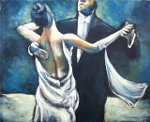|
|
Foot Follows Frame
by Harold & Meredith Sears
We recently ran across a
"well-known
rule of movement in dance: foot follows frame." Experienced
dancers follow this rule. They move the frame, their torso, and then
move the foot. But beginners do the opposite -- they move the foot
first and then the torso. In dancing, beginners think of the steps.
They think of their feet first, and so they lift their feet too high,
they step too far, and the body is then dragged onto the feet. So it
looks like marching, or a game of hopscotch, or a camel. (This writer
was cruel.)
But experienced dancers think not
of
the foot but of the frame. They move the frame first, and the foot
follows along naturally. If they do think of the foot, they think of
the supporting foot, which is under them, not the free foot, which
will move and eventually take the weight. The supporting foot is the
"sending" foot, and it pushes into the floor and moves the
frame on its way. Then we move the free foot, the "receiving"
foot, and at the proper moment (on the beat?) we lower it to the
floor, as the frame (in motion) passes that point. The receiving foot
takes weight -- we have taken the step.
But notice how different these two
approaches are. Our hypothetical beginner reaches forward with the
free foot, contacts the floor ahead of the frame, and then drags
himself onto that foot. The thought sequence is receiving foot, then
the frame, and maybe there was no thought for the sending foot at
all. The result is jerky, even clumping. In contrast, the experienced
dancer thinks about the sending foot first, initiates movement of the
frame, and, yes, he has a thought for the receiving foot, but he
keeps it under him. He doesn't reach out and then leap onto it. The
body's center is centered over its support. Move your center first,
and your feet will follow. The result is smooth, flowing, and
continuous.
 One of our teachers offered us an image
-- think of a chair being moved from here to there across the floor.
The legs are solidly under the mass of the chair at all times. The
chair never gets out in front of its legs, and the legs never step
out in front of the chair. The chair is centered over its legs
always. One of our teachers offered us an image
-- think of a chair being moved from here to there across the floor.
The legs are solidly under the mass of the chair at all times. The
chair never gets out in front of its legs, and the legs never step
out in front of the chair. The chair is centered over its legs
always.
Both in moving a chair and in
Smooth
dancing, we want to keep our frame centered over its support. The
feet are moving, but in the Smooth rhythms, it is really the frame
that is dancing. The frame is progressing, turning, spinning -- this
is the dance. The feet are in the service of the frame. We don't want
the foot moving and the body trailing along behind it or catching up
to it. Such a strategy will feel jerky and feel off the beat. It's
not that we never reach out with the free foot. We reach for a Right
Lunge and for a Contra Check, but we don't take weight until the
frame is in position.
Dance is turns, more than linear
motion, and during turns too, foot follows frame. The body moves
first, preparing for the turn, and then the turn occurs. During a
foxtrot Reverse Turn, the man steps forward, initiates upper-body
turn, steps side and forward with foot turn (lady Heel Turn),
continues upper-body turn until his center is facing RLOD, and then
steps back to complete the foot turn. At each step, the frame turns
first and then the foot.
So, as you dance, think first about
your solar plexus and second about your feet. There really is
substantial time between any two beats of music. Use that time to
move your frame forward, to move the man's right shoulder forward
into a Reverse Turn. As your frame dances, your feet will be there
to carry you along, and your dance will flow more smoothly.
Idea
from Every Man's Survival Guide To Ballroom
Dancing by James Joseph, p87, 2010. A brief version was
published in the Washington Area Square Dancers
Cooperative Association (WASCA) Calls 'n'
Cues, March 2012. An expanded version was published in the
DRDC Newsletter, September
2012.

If you would like to read other articles on dance
position, technique, styling, and specific dance rhythms, you may visit
the article TOC.
Past DRDC Educational Articles archived here.
Go beyond this site. Find other references on our Sources and Links
pages.
|

